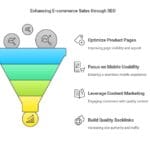
Search engine optimization (SEO) has undergone a seismic shift over the years, evolving from keyword-stuffing tactics to a sophisticated interplay of user-centric strategies. At the core of this transformation lies an essential element: user intent. Understanding and catering to user intent not only improves search engine rankings but also enhances user satisfaction, increases conversion rates, and builds long-term brand trust. This article delves deep into the concept of user intent, its types, significance in SEO content writing, and practical tips for integrating it into your strategy, all while adhering to EEAT (Expertise, Authoritativeness, Trustworthiness) principles.
What is User Intent?
User intent, also known as search intent, refers to the purpose or goal behind a user’s search query. It’s the “why” that drives people to type certain words into a search engine. By understanding user intent, you can create content that aligns with the needs and expectations of your audience, thereby increasing the likelihood of engagement and satisfaction.
Search engines like Google have become highly adept at discerning user intent through sophisticated algorithms, prioritizing content that directly addresses the user’s underlying needs over content that merely matches keywords.
Types of User Intent
- Informational Intent Users seek knowledge or answers to specific questions. These queries often start with words like “what,” “how,” “why,” or “when.” Examples:
- “What is user intent in SEO?”
- “How to improve website speed?”
- Navigational Intent Users want to visit a specific website or find a particular brand. These queries often include brand names or direct references. Examples:
- “Facebook login”
- “Nike running shoes”
- Transactional Intent Users are ready to make a purchase or complete an action. These queries may include words like “buy,” “discount,” or “near me.” Examples:
- “Buy iPhone 15 online”
- “Best pizza near me”
- Commercial Investigation Users are researching products or services but haven’t decided yet. These queries often include comparisons or reviews. Examples:
- “Best laptops under $1,000”
- “Top-rated digital marketing courses”

Why is User Intent Crucial in SEO Content Writing?
1. Enhances User Experience
Content that aligns with user intent provides immediate value, keeping visitors engaged. This reduces bounce rates and increases the time spent on your site, key factors in Google’s ranking algorithm.
2. Improves Search Engine Rankings
Google’s algorithms prioritize content that satisfies user intent. Focusing on intent boosts relevance, making your content more likely to appear at the top of search engine results pages (SERPs).
3. Increases Conversion Rates
When content matches the user’s stage in the buyer’s journey, it guides them seamlessly toward completing a desired action, such as making a purchase or signing up for a newsletter.
4. Builds Brand Authority and Trust
Consistently providing content that meets user needs establishes you as an authoritative and reliable source of information, enhancing your EEAT score.
Aligning Content with User Intent: Best Practices
1. Conduct Thorough Keyword Research
Keyword research is the foundation of understanding user intent. Use tools like Google Keyword Planner, Semrush, or Ahrefs to identify the most relevant queries and their intent.
Tips:
- Group keywords based on intent.
- Analyze SERPs to understand what type of content Google favors for specific keywords.
2. Analyze Search Engine Results Pages (SERPs)
The SERP layout often reveals user intent. For example:
- Featured snippets suggest informational intent.
- Shopping ads indicate transactional intent.
- Knowledge panels align with navigational intent.
3. Create Content for All Stages of the Buyer’s Journey
Each stage of the buyer’s journey aligns with different user intents:
- Awareness Stage: Informational content like blogs, guides, and videos.
- Consideration Stage: Comparison articles, reviews, and case studies.
- Decision Stage: Transactional content like product pages and special offers.
4. Optimize Content Structure
Clear, well-structured content improves readability and user engagement.
Include:
- Headings and subheadings that align with user questions.
- Bullet points and numbered lists for easy scanning.
- Visual aids like images, charts, and videos to enhance understanding.
5. Leverage EEAT Principles
To build trust and authority, focus on:
- Expertise: Provide accurate, in-depth information backed by credible sources.
- Authoritativeness: Highlight your qualifications, certifications, and industry experience.
- Trustworthiness: Ensure secure browsing, include testimonials, and maintain transparency.
6. Monitor and Update Content Regularly
User intent can evolve over time. Regularly update your content to ensure it remains relevant and aligned with current trends and user needs.
Tools to Understand and Optimize User Intent
1. Google Analytics and Search Console
Analyze user behavior, bounce rates, and search queries to gain insights into intent.
2. Heatmap Tools
Tools like Hotjar or Crazy Egg help visualize how users interact with your content.
3. Content Optimization Tools
Tools like Clearscope and Surfer SEO provide recommendations for aligning content with user intent and improving readability.
4. AI and NLP Models
Leverage AI-driven tools to analyze large datasets and predict user intent accurately.
Examples of User Intent in Action
Informational Intent
Example: Blog Post on “How to Improve Your Website’s SEO”
- Target Audience: Beginners in SEO.
- Content Strategy: Provide actionable tips, use visuals, and link to in-depth guides.
Navigational Intent
Example: Landing Page for “Shopify”
- Target Audience: Users searching for Shopify’s official site.
- Content Strategy: Create a branded landing page with easy navigation and direct links.
Transactional Intent
Example: Product Page for “Buy Organic Coffee Beans”
- Target Audience: Buyers looking for organic coffee.
- Content Strategy: Highlight product features, include customer reviews, and offer a clear call-to-action.
Challenges in Addressing User Intent
- Ambiguous Queries Some queries can have multiple intents. For example, “Apple” could refer to the fruit or the tech company.
Solution:
Analyze user behavior and tailor content accordingly.
- Dynamic Intent User intent may shift over time, requiring continuous monitoring and adaptation.
Solution:
Stay updated with industry trends and user feedback.
- Competing for High-Intent Keywords High-intent keywords often have stiff competition.
Solution:
Focus on long-tail keywords and niche topics to capture specific segments.
Conclusion
User intent is the linchpin of effective SEO content writing. By understanding and addressing the “why” behind search queries, you can create content that resonates with your audience, boosts engagement, and drives measurable results. Incorporating user intent into your strategy is not just about improving rankings; it’s about building meaningful connections with your audience, fostering trust, and achieving long-term success. By adhering to EEAT principles and staying attuned to evolving user needs, you can ensure that your content remains relevant, impactful, and authoritative in the ever-changing digital landscape.





